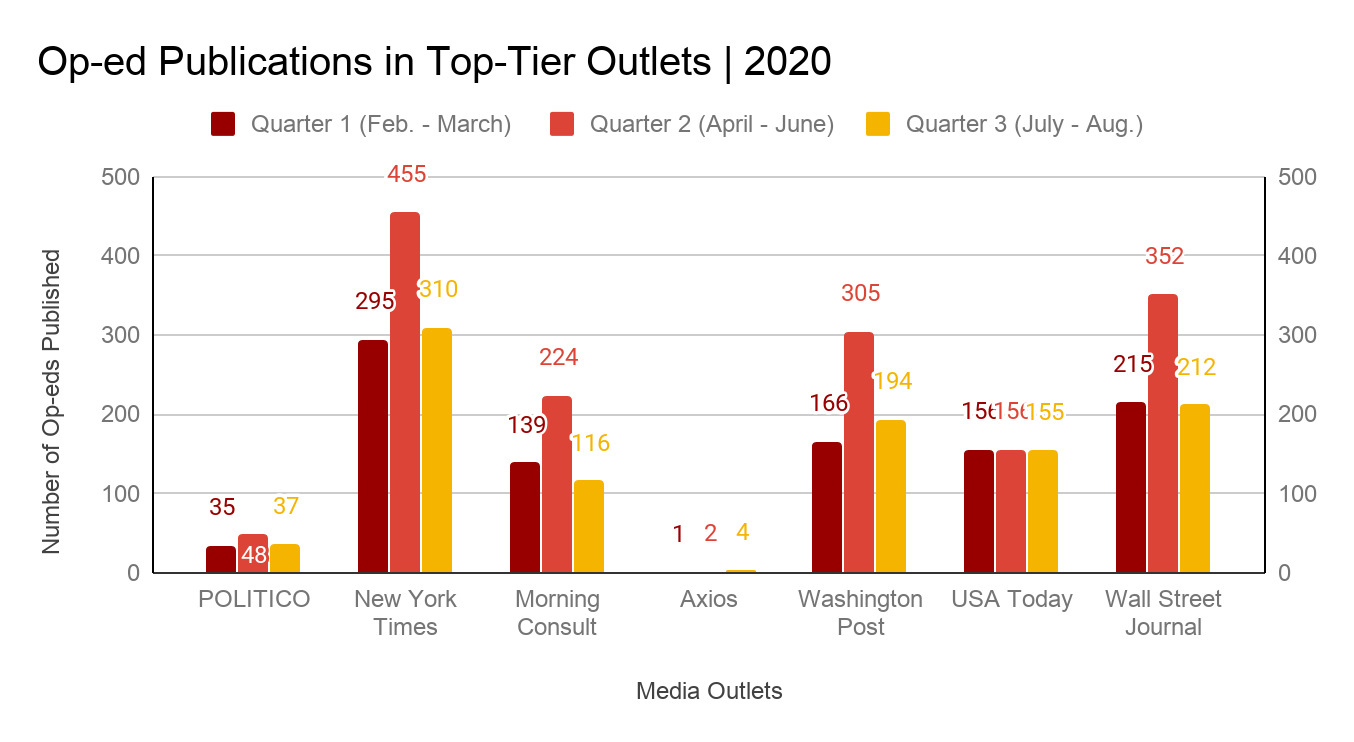Insights
Writing an Op-Ed? Think Again..

Op-eds provide experts with a coveted piece of real estate to articulate their messages and publicize their names. However, it’s time we address that op-eds have changed a lot in the last 60 years—the prevailing wisdom on how, and where, you can place them, and the type of impact they have has shifted dramatically. Over the last seven months, top-tier outlets have been inundated with “thought leaders” trying to get their perspectives out into the public as traditional earned media hits have dried up in the wake of COVID-19 coverage. As a result, in early September, we audited who was publishing op-eds, how frequently, and just how impactful they were.
What’s different about the media?
The media landscape has drastically changed over the course of this year. Newsrooms across the country have shrunk at unprecedented rates as a result of the COVID-19 pandemic and the ensuing recession.
According to Pew, in 2008, there were roughly 114,000 newsroom employees in the U.S. In 2019, that number fell to 88,000, while 1,800 print outlets shut their doors between 2004 and 2015. These rates are only accelerating due to the current state of the economy.
As a result, fewer reporters are now expected to publish more content than ever before. Simultaneously, there’s also more than enough important news to cover: the COVID-19 pandemic, ongoing protests around racial injustice, natural disasters, and the looming presidential election. Yet in the environment we live in, organizations and thought leaders have more objectives to accomplish, more messaging to share, and more time to author content.
Who’s publishing and how much?
Clyde Group analyzed seven publications with sizable audiences inside the Beltway: POLITICO, New York Times, Morning Consult, Axios, Washington Post, USA Today, and Wall Street Journal. Our analysis began on February 1—when rumblings of COVID-19 started to hit the U.S.—and went through August 31, 2020. Various trends became immediately apparent.
 What does this mean?
There has been a tsunami of content in 2020 compared to the flood in 2019. As a result of the sheer volume of op-eds being published, their impact is diminishing (proof that no industry is exempt from the law of supply versus demand). When our team examined interactions with op-ed pieces, we found that with rare viral exceptions, the overall social media engagement across Facebook and Twitter was relatively low.
Knowing this, the question becomes whether it’s worth investing resources into authoring and placing op-eds. Our answer is still a resounding “yes.” Op-eds give you the breathing room to explain your argument, lay out your policy position, and reach a large number of people for little-to-no cost. They also give you the flexibility to articulate your message without the constraints of a podcast editor, news producer, or journalist looking for a punchy sound bite.
However, organizations must first answer the following questions before considering a byline: Is the message you’re trying to deliver best suited for an op-ed or another tactic? Are you willing to stake out a powerful position, or are you writing this purely for name recognition? If you get published, what is your strategy to make the most out of your placement? In other words, how are you going to promote your piece and get relevant audiences to engage with it?
In an age where we are inundated with information, always take the time to develop your distribution plan and carve out your messaging objectives. Doing so will ensure that your op-ed doesn’t get lost in the noise.
What does this mean?
There has been a tsunami of content in 2020 compared to the flood in 2019. As a result of the sheer volume of op-eds being published, their impact is diminishing (proof that no industry is exempt from the law of supply versus demand). When our team examined interactions with op-ed pieces, we found that with rare viral exceptions, the overall social media engagement across Facebook and Twitter was relatively low.
Knowing this, the question becomes whether it’s worth investing resources into authoring and placing op-eds. Our answer is still a resounding “yes.” Op-eds give you the breathing room to explain your argument, lay out your policy position, and reach a large number of people for little-to-no cost. They also give you the flexibility to articulate your message without the constraints of a podcast editor, news producer, or journalist looking for a punchy sound bite.
However, organizations must first answer the following questions before considering a byline: Is the message you’re trying to deliver best suited for an op-ed or another tactic? Are you willing to stake out a powerful position, or are you writing this purely for name recognition? If you get published, what is your strategy to make the most out of your placement? In other words, how are you going to promote your piece and get relevant audiences to engage with it?
In an age where we are inundated with information, always take the time to develop your distribution plan and carve out your messaging objectives. Doing so will ensure that your op-ed doesn’t get lost in the noise.
- The New York Times published far more opinion content than any other publication, while Axios published the least. Due to their respective publishing and business models, this wasn’t surprising.
- The majority of publications saw significant spikes in the number of op-eds published during what we refer to as the “COVID Quarter” between April and June. Unsurprisingly, the majority of the pieces focused on COVID-19—economic impact, health care, treatments and vaccines, future of work, and more.
- There was no correlation between someone’s title and their likelihood of being published. Sure, if the author is a senator, governor, or other notable public official, their chances increase. However, when looking at more “mundane” titles across various industries, there was no advantage to being a CEO or president versus an attorney, physician, or researcher.
 What does this mean?
There has been a tsunami of content in 2020 compared to the flood in 2019. As a result of the sheer volume of op-eds being published, their impact is diminishing (proof that no industry is exempt from the law of supply versus demand). When our team examined interactions with op-ed pieces, we found that with rare viral exceptions, the overall social media engagement across Facebook and Twitter was relatively low.
Knowing this, the question becomes whether it’s worth investing resources into authoring and placing op-eds. Our answer is still a resounding “yes.” Op-eds give you the breathing room to explain your argument, lay out your policy position, and reach a large number of people for little-to-no cost. They also give you the flexibility to articulate your message without the constraints of a podcast editor, news producer, or journalist looking for a punchy sound bite.
However, organizations must first answer the following questions before considering a byline: Is the message you’re trying to deliver best suited for an op-ed or another tactic? Are you willing to stake out a powerful position, or are you writing this purely for name recognition? If you get published, what is your strategy to make the most out of your placement? In other words, how are you going to promote your piece and get relevant audiences to engage with it?
In an age where we are inundated with information, always take the time to develop your distribution plan and carve out your messaging objectives. Doing so will ensure that your op-ed doesn’t get lost in the noise.
What does this mean?
There has been a tsunami of content in 2020 compared to the flood in 2019. As a result of the sheer volume of op-eds being published, their impact is diminishing (proof that no industry is exempt from the law of supply versus demand). When our team examined interactions with op-ed pieces, we found that with rare viral exceptions, the overall social media engagement across Facebook and Twitter was relatively low.
Knowing this, the question becomes whether it’s worth investing resources into authoring and placing op-eds. Our answer is still a resounding “yes.” Op-eds give you the breathing room to explain your argument, lay out your policy position, and reach a large number of people for little-to-no cost. They also give you the flexibility to articulate your message without the constraints of a podcast editor, news producer, or journalist looking for a punchy sound bite.
However, organizations must first answer the following questions before considering a byline: Is the message you’re trying to deliver best suited for an op-ed or another tactic? Are you willing to stake out a powerful position, or are you writing this purely for name recognition? If you get published, what is your strategy to make the most out of your placement? In other words, how are you going to promote your piece and get relevant audiences to engage with it?
In an age where we are inundated with information, always take the time to develop your distribution plan and carve out your messaging objectives. Doing so will ensure that your op-ed doesn’t get lost in the noise.